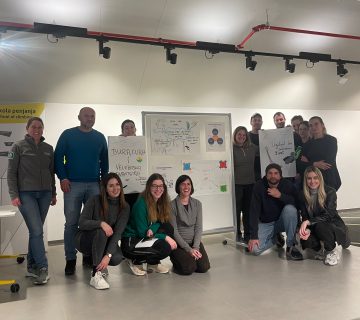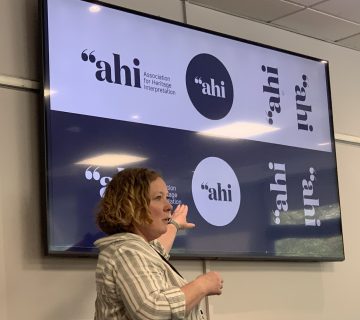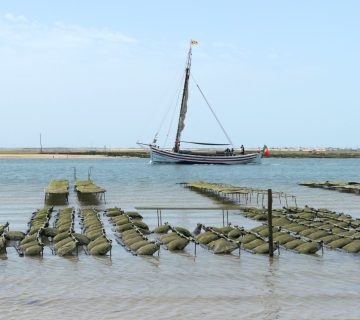IE’s Module on Live Interpretation (MLI) reached a milestone when it was tested in Prague.
Interpret Europe has been working on the development of training for live interpretation for years. Costumed performances immerse the visitors into another time and place. It presents an opportunity to bring a historical site to life, to reflect on the past, and to craft a meaningful experience. However, crafting such training brings a lot of challenges. Over the years, we have tried to overcome those challenges. This spring, we tested the completed module in Prague.
Development of the training
The original plan was to create a five-day certified training course. We still haven’t abandoned that idea, but the practice has shown that it’s difficult to organise. We have been focused on making a shorter module work as smoothly as possible. The first pilot training took six days, and it took place in Budapest, Hungary, back in 2018. It was organised in collaboration with the UK-based company, Past Pleasures, and the trainers were Past Pleasure’s Kate Howard and Mark Wallis, both experienced live interpreters and trainers in that field. Some Interpret Europe trainers took part in this course, and this was very beneficial as it was easier to adjust the content. The goal was to make it more relevant to our members and to highlight the heritage interpretation principles.
The next opportunity for pilot training took place in Split, Croatia, in 2020. This time, our then-training coordinator and one of the most active contributors to IE’s training programme, Valya Stergioti, joined forces with Mark Wallis. Together they balanced the arts of being a skillful costumed performer and an interpreter who creates meaningful experiences. It was decided afterward that it should, for now, be limited to a shorter module. Iva Silla, an IE trainer and experienced live interpreter from Secret Zagreb, took over the task and worked closely with IE’s training coordinators and Mark Wallis. She has been actively involved in schedule adjustments and created new exercises, testing them on several occasions in Croatia. The Czech Institute for Heritage Interpretation also hosted Mark Wallis for a five-day training in June 2023 organised by Michal Medek.
Finally, this spring, Michal organised a complete two-day training based on Iva Silla’s outline, and this was a chance to test everything in detail. Ten participants, mainly museum employees from the Czech Republic and Slovakia, actively took part. They offered detailed feedback and gave us valuable insight, confirmed some of our doubts and uncertainties, and allowed us to fine-tune and wrap up the module.
Challenges and concerns
The main struggle with the creation of this training is to offer a good balance of content. Judging from our experience, participants usually come from diverse backgrounds and have a varied comprehension of both live interpretation and interpretation overall. In just two or three days, we should be able to address the ones who have experience in live performances, and those who don’t, those who understand the qualities of heritage interpretation, and those who don’t. We should be able to implement IE’s training principles and meet the expectations of a wide range of participants, and partner organisations.
Based on the feedback of the participants from the recent training, and the feedback of the participants who had tested out some of the exercises beforehand, we have managed to combine all of this and create a very efficient training module that offers a motivating learning environment.
Another main concern is that the module might actually be too short after all. The feedback says that it was very intense, and we could use more time for discussion and exchange. As trainers, we agree that this module is much more intense than other modules that Interpret Europe offers. Our recommendation would be to spread it over three days. In the future, we could aim towards developing a five-day training course, but we are still happy to offer this module as, in a very short time, it offers a chance for the participants to feel empowered and grow as professionals in the field of live interpretation. It also creates a firm base to continue their work and build their characters.
Training in Prague
The training in Prague took place on 30 April – 1 May in a baroque mansion. It was a perfect venue – recently renovated, but its rooms are empty, which showed us the power of live interpretation for bringing places to life. The palace was open for visitors, too, and they were very intrigued by the participants’ performances. That gave the participants a unique chance to perform for real audiences and to realise the effect costumed interpretation has.
We were eager to try the optimal version of the training by securing costumes for everyone, even the trainers. Two trainers delivered the module on site and we also invited Mark Wallis to join us for an hour-long online presentation. He shared his vast experience and the participants spoke highly about this part.
Some of the topics included in the training module are: the qualities of heritage interpretation; understanding of themes; body language; improvisational skills; ways to involve the audience; dealing with difficult situations and participants; peer-evaluation; and developing a character and a scene.
Throughout the module, participants add to a board more dos and don’ts of live interpretation based on what they have learned. On the second day, the participants combined all those skills to create a scene. It was very demanding. They were supposed to bring the site to life and make it relevant for the performance to take place right there. They were supposed to offer a meaningful performance, guided by an interpretive theme. Finally, this wasn’t even supposed to be a performance, instead, it was supposed to be an interpretation that would involve the visitors.
Next steps
When developing a new training offer, one of our main challenges is finding the opportunity to repeatedly run them and starting a network of adequate trainers. All of the pilot trainings happened thanks to the support of our partners, such as the Hungarian Museum of Trade and Tourism, Interpret Croatia and Muze from Croatia, the Czech Institute for Heritage Interpretation and Visegrad fund.
We now search for colleagues who have valuable experience in costumed performances that involve visitors in order to review the module and become future Interpret Europe live interpretation trainers.
Another important step in the implementation of this module will be creation of a manual. Literature about live interpretation is scarce, and some of our members can offer valuable insight that could help future live interpreters in their work. We are searching for a funding opportunity to develop such a manual.
Would you like your stakeholders or employees to improve their skills through a unique training experience packed with practical exercises? Interpret Europe might be able to help with the brand-new Module on Live Interpretation. Let’s bring our heritage sites to life!
Iva Silla is an IE Certified Interpretive Trainer. She is the author of Secret Zagreb activities (www.secret-zagreb.com) and the Croatia Underrated podcast (www.croatiaunderrated.com). She can be contacted at: iva@questoftales.com. Michal Medek is one of IE’s Training Coordinators. Contact him at: michal.medek@interpret-europe.net.
To cite this article: Silla, Iva & Medek, Michal (2024) ‘Taking you to another time and place‘ in Interpret Europe Newsletter 2-2024, pg. 10-11.
Available online: https://interpret-europe.net/wp-content/uploads/2024/07/PDF-Newsletter-2024_2.pdf




